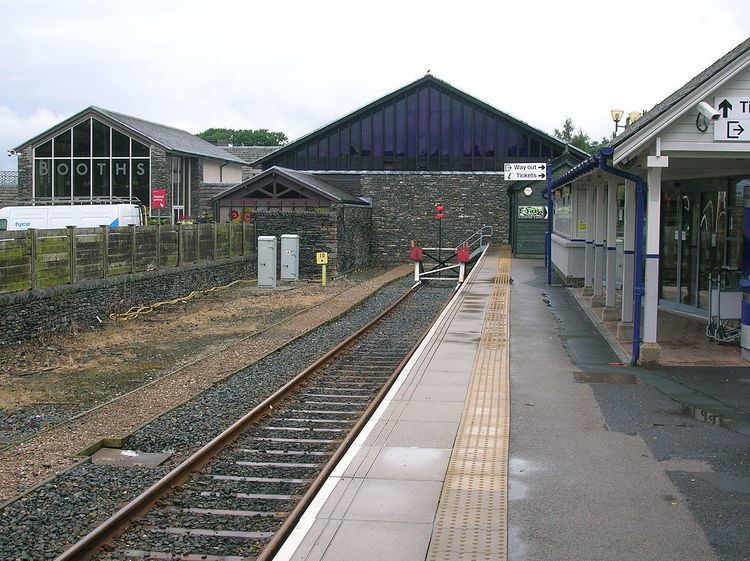 | ||
Poem on the projected kendal and windermere railway william wordsworth
The Kendal and Windermere Railway is a railway in Cumbria in north-west England. It was built as a railway from the Lancaster and Carlisle Railway at Oxenholme via Kendal to near Windermere, opening fully in April 1847. The engineer was Joseph Locke and the partnership of contractors consisted of Thomas Brassey, William Mackenzie, Robert Stephenson and George Heald. It remains open, albeit in much simplified form, as the Windermere Branch Line.
Contents
- Poem on the projected kendal and windermere railway william wordsworth
- History
- Opposition
- Construction
- Leases
- Train services
- Electrification
- References
History
The Kendal & Windermere was promoted because of concerns that the Lancaster and Carlisle Railway (which now forms part of the West Coast Main Line from London to Glasgow) was not planned to go via Kendal. Although a 3.5 km tunnel north of Kendal was proposed to allow the L&CR to be routed via Kendal, that was too expensive, and the line seen today was adopted, running 1.5 km east of Kendal and then turning north-east.
As a result, efforts were put towards a branch line from the L&CR at Oxenholme, to run through Kendal to Windermere. In this context, "Windermere" meant the lake, the Windermere station terminus being at the village of Birthwaite about one kilometre from the lake, the village only later becoming known as Windermere. Oxenholme's railway station is now known as 'Oxenholme Lake District' because of the branch line.
Opposition
There was opposition to the proposals from those who were against what they saw as destruction of the Lake District landscape. Those opposing included the poet William Wordsworth. His letters to the editor of the Morning Post are reproduced in The Illustrated Wordsworth's Guide to the Lakes, P. Bicknell, Ed. (Congdon and Weed, New York, 1984), pp. 186–198. His reactions to the technological and "picturesque" incursions of man on his beloved, wild landscape most famously include the following sonnet:
On the opening of the railway in 1847 one of the contracting engineers, George Heald, wrote an impassioned riposte to Wordsworth accusing him of wanting to obstruct the opportunities the railway would bring. It is dated April 15, 1847, the Locomotive at Orrest Head. He argues for the democratising influence of the railway and the cultural and social benefits it will bring rather than the economic reasons that might be expected from a railway engineer:
Construction
Despite this opposition, the Kendal and Windermere Railway Act authorising construction received the royal assent on 30 June 1845, and when the L&CR opened southwards from Oxenholme on 22 September 1846, the route to Kendal was already built. On 20 April 1847, the through route to Windermere station was opened.
Leases
The railway was leased in perpetuity to the Lancaster & Carlisle on 3 May 1858; the following year, the L&CR was leased to the London and North Western Railway, which put the whole of the West Coast Main Line under their control; in 1923 the LNWR became part of the London, Midland and Scottish Railway.
Train services
The branch had a variety of through services at various dates, including to London, Manchester, Preston, Grange over Sands, as well as many special excursion trains. In 1966 it was reduced to a local service only (to/from Oxenholme & Carnforth), and on 3 August 1968 the last steam train ran on the line. Goods traffic on the branch finished in 1972. The double track branch became single track in 1973 (as part of the WCML resignalling scheme) to save money. In 1994, the branch began what may be seen as a renaissance, with through trains introduced to Manchester Airport, which are now run by TransPennine Express.
Electrification
With the West Coast Main Line electrified, consideration was given to electrifying the branch, but this was not carried out. The possibility of electrifying the branch was raised again in June 2013, when a feasibility study was announced in parliament by the government.
In August 2013, the Department for Transport announced that the line is to be electrified by 2016 as part of the wider scheme to wire many other routes in the North West of England (such as the Manchester to Preston Line). The £16 million scheme will allow through trains from Lancaster & points south to continue using electric rolling stock (such as the Class 350 "Desiro" units) rather than the current DMUs and also improve capacity on the route, though it is not yet clear as to whether the plans will include track & signalling upgrades to permit a more frequent service to operate.
